|
WELCOME!
 We
welcome you to Christ Church Cathedral, Lisburn whether you come as a
tourist, as a visitor or simply seeking a peaceful place for prayer.
There has been a Christian church on this site for over 350 years and in
this booklet we hope to tell you something of its past and guide you to
some of the interesting parts of the building. We also hope that you
will sense that the Cathedral is a living church - where part of the
Body of Christ meets for worship - not simply another historic building. We
welcome you to Christ Church Cathedral, Lisburn whether you come as a
tourist, as a visitor or simply seeking a peaceful place for prayer.
There has been a Christian church on this site for over 350 years and in
this booklet we hope to tell you something of its past and guide you to
some of the interesting parts of the building. We also hope that you
will sense that the Cathedral is a living church - where part of the
Body of Christ meets for worship - not simply another historic building.
The church of St Thomas, founded on this site in 1623,
was a Chapel-of-ease for the castle which stood in what is now Castle
Gardens park beside the Cathedral. As the settlement around the castle
grew, St Thomas' Church served as a focus for Christian worship in this
area. Although the castle is no longer to be seen, the present Cathedral
continues to provide a focus for Christian worship and ministry at the
centre of the original settlement which has become the present busy
provincial town.
As you can read in the historical pages of this booklet,
the building has seen several major exterior changes over the centuries;
it has been reconstructed, reinforced, enlarged and made more visible by
the addition of its lofty spire. It has shared in times of conflict and
times of prosperity affecting the lives of people in this district. It
has also been influenced by the organisation of the two Church of
Ireland dioceses, Connor and Down
The interior has changed also by the addition of the
gallery, and rearrangement of the chancel area. When the present chancel
was constructed more than a century ago it created space for choir
stalls and sanctury; this area was again changed in recent years by
moving the choir seating into the main body of the building, making it
possible to extend the communion rail. With increased space in the
chancel, it is possible to have many differing arrangements of musicians
and singers for some of the newer forms of service like praise services
and family services.
Although the building has seen changes in the form of
worship and the contribution of music, the central purpose of the
Cathedral has not changed: it endures as a place for the worship of the
living God and as a beacon for Christian faith in this town and
district.
When you have viewed the building with its many
memorials to men and women who have worshiped here and contributed to
the heritage that we now enjoy may we invite you to come and join with
us in worshipping God at one of our regular services at the times shown
on the notice board

A BRIEF HISTORY
St Thomas' Church
About the year 1609, a Welsh officer, Sir Fluke
Conway, settled in Lisnagarvey (as the district was then called) and
built, or rebuilt, a castle on the highest point overlooking the river
Lagan in what is now Castle Gardens park. In 1623 he constructed a
church, dedicated to St Thomas, on the site of the present Cathedral as
a chapel-of-ease for the castle. St Thomas' Church was much smaller than
the present cathedral but little is known of its architecture. As the
settlement of Lisnagarvey grew around the castle the church began to be
used as a place of worship for the townspeople. The earliest map of the
settlement shows houses fronting on to Bridge Street and the present
Castle Street forming the market place with the church occupying the
area between the converging streets.
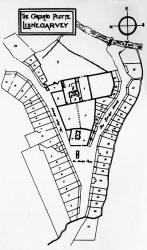 |
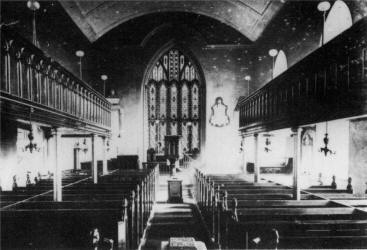 |
Settlement map
of about 1640 |
The
earliest photograph of the Cathedral interior (1885) |
The Events of 1641
In 1641 the town was attacked by a rebel army and in
protracted battles between
October and November St Thomas' Church was destroyed
. The rebels led by Sir Con Magennis were defeated at Lisburn, thereby
protecting the towns of Belfast and Carrickfergus. Although civil
conflict continued in Ireland for eight years with hostilities in other
towns, there was comparative peace in Lisburn and the church was
reconstructed.
In 1662, while Jeremy Taylor was bishop of Down and
Connor, the church of Lisburn was granted a charter by Charles II as the
Cathedral of the United Diocese. There is no record of major
construction associated with its Cathedral status, although the vestry
book records that sums of money were raised for the repair and
enlargement of the church and churchyard. In particular, the tower was
constructed in 1674, providing access to the original gallery which was
erected in the same year. The building was in good repair and well cared
for in 1697 when the first of the Huguenot families began to settle in
the town. Although the Huguenots established their own church in Castle
Street they were associated with the Cathedral and several members of
the original families were buried in the Cathedral churchyard.
The Fire of 1707 and Reconstruction
In the more settled period that followed the
Williamite wars the district was prospering when, in April 1707, the
town of Lisburn and the church and castle were destroyed in a disastrous
fire. There seemed to be no urgency to rebuild the castle for the
defence of the town but in the following year, on 20th August 1708, "the
foundation of the new Church of Lisburn began to be laid". Construction
of the present building, the third to stand upon the site, continued for
several years and was still in progress in 1714. In its original form
the building was rectangular, extending to the east wall where the
chancel now stands. Some reconditioning of the tower was carried out at
this time but the spire was to follow almost a century later. The clock
and bell tower were presented by the Marquis of Hertford. The vestry was
added in 1727 and is of similar construction to the original rectangular
nave.
The slim, octagonal spire of cut stone with its base
on the tower was constructed between 1804 and 1807 creating the most
prominent feature in the middle part of the Lagan valley.
By the time of the earliest photographic record in
1885 the perpendicular east window was still in place, a gallery had
been added and the pulpit was in a central position. Heating was
provided by two stoves in the aisle but the layout of pews and aisles
was similar to today. With improving prosperity the Cathedral was ready
for enlargement.

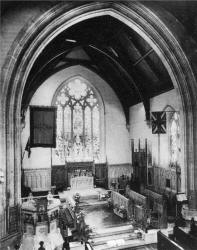 |
Chancel with flags and choir stalls -1954 The
colours on the north side are those of the 11th Battalion of
the Royal frith Rifles carried at the Battle of the Somme
where the Ulster Division suffered terrible casualties. The
flag pictured on the south wall is the colour of the Fourth
Antrim Battalion of the Ulster Volunteer Force raised in
1913 by Sir Edward Carson, |
Extension and Reinforcement
During the period 1884 - 1917 while Canon Pounden was
Rector, the Cathedral was extended in a major way by the addition of the
present chancel. Most of the east wall was replaced by a graceful gothic
arch in 1889 and substantial buttresses of dressed stone were
constructed to reinforce the external walls of the nave. Pictorial
windows in memory of Sir Richard Wallace and the Bishops and Rectors
were dedicated and in 1890 the Glastonbury chair was presented, choir
stalls were located in the chancel and an ornamental stone pulpit
positioned at the foot of the chancel steps. In this vigorous period of
building the present parish hall was constructed to serve as a Sunday
School on a portion of land granted from the adjoining Castle Gardens
park.
The War Years
The First World War was a time of great loss for the
Cathedral Parish and is commemorated by memorial tablets in the porch.
For many years the regimental colours from this conflict were displayed
in the chancel.
The years between the wars saw considerable new
growth as a picture of 102 men comprising the Cathedral Bible class in
1929 bears witness.
Fewer lives were lost by servicemen from the parish
in the Second World War. The Chapter Stalls in the Chancel are dedicated
to their service.
Development to Meet Changing Needs
The major post war change to the interior was the
dedication in 1950 of the east window depicting Christ in Glory. It was
presented by Sir John Milne Barbour.
In 1990 the present spacious chancel area was created
by moving choir seating to a raised area below the pulpit. The communion
rail was extended and new chancel steps in white marble were installed.
The stone pulpit had become unsound and was replaced.
THE CATHEDRAL IN THE DIOCESE OF CONNOR
To understand the historical background to the
Cathedral in the Diocese of Connor it is necessary to go back several
centuries, and to understand that Down and Connor Diocese were in union
for 500 years and that Down Cathedral lay in ruins from the suppression
of the monasteries in 1541 until 1790.
About the year 500 A.D. Aengus MacNisse, a pupil of
St. Patrick, is said to have founded the church of Connor and to have
been its fist Bishop. In 1442 the Diocese became a Union with Down and
so remained until 1944. In ancient times the Diocese of Connor does not
appear to have had a Cathedral or Dean and Chapter. In 1609, however,
James I founded a Chapter for St. Saviour, Connor, but apparently no
Cathedral was provided for them. Since 1662 this Chapter has been, and
still remains, the Chapter of Lisburn Cathedral.
The "Transmiss" of the Charter given by Charles II
establishing this church as a Cathedral, is preserved in the Public
Records Office in Belfast.
An extract from this document reads:-
"And whereas the Church of Lisburne alias
Lisnagarvie, in the county of Antrim and Diocese of Down, being
situate near the middle of the dioceses aforesaid; and now united,
can more Conveniently serve for a Cathedral Church for the
bishopricks aforesaid, we have erected, created, founded,
ordained; made, constituted and established the said church of
Lisburne, alias Lisnagarvie, and place of the same Church to be for
ever hereafter the Episcopal seat of the aforesaid several
bishopricks of Down and Connor and to continue for ever in all
future times"
However, some years ago a question was raised as to
the validity of the Charter granted by Charles II. It was suggested that
the instrument had never been made effective and that the Charter had
never received the sanction of Parliament, nor was the Royal Seal
affixed. It was suggested by some scholars of ecclesiastical history in
Ireland that this Church is a Cathedral only in name and by centuries of
use. In order to remove all doubts as to the status of our Cathedral the
Bishop of Connor, at that time, Bishop Charles King Irwin, introduced a
Bill at the General Synod of the Church of Ireland in 1952. This measure
recognised Lisbum Cathedral as the Cathedral of the Diocese of Connor,
known as the Cathedral of Christ Church, Lisburn.
The Diocese of Connor covers approximately the area of
County Antrim including the part of Belfast to the north of the river
Lagan.

GUIDE TO FEATURES OF INTEREST
THE WEST ENTRANCE
The double gates from Market Square provide the best
visibility from the town. The gateway was widened in 1924 by the
demolition of an adjacent building but this gateway and the archway from
Castle Street have provided access from the 18th century. The main
entrance is from the door on the south side of the porch at the
base of the tower. The gothic doors visible from the main entrance gates
are for visual symmetry; there is no actual doorway since the stairs to
the gallery are supported from the west wall of the tower.
Memorials, listing the names of 48 men from the
Cathedral Parish who gave their lives in the Great War, and the names of
196 men who served, are engraved on tablets on either side of the
entrance to the nave.
THE TOWER AND BELLS
The tower was originally built in 1674 to provide
access to the gallery. Its main structure survived the fire
of 1707. The walls are constructed of local stone and are slightly inset
at each floor. The clock and bells were a gift from the Marquis of
Hertford. The robing bell was recast in 1746, the two small clock bells
cast in 1796 and the large tolling bell or curfew bell recast in Dublin
in 1861 An early historical note states:- `There is a handsome clock and
chimes, likewise a valuable bell of very superior tone, the hour is
proclaimed loquaciously with eight tongues"
The tercentenary invitation, in 1923 records:-
The curfew is still Ring every night at 9 o'clock'
100 strokes of the large bell being given, and the inhabitants hear now
as of yore, the hour chimed, while those in the adjacent surrounding
neighbourhood enjoy the same privilege, and in addition have a
perspective view of the Cathedral's tall and graceful spire which has
stood the blast of many a storm.
The bell rope is accessible from the floor of the
west entrance porch and is expertly pulled to ring the tolling bell
before morning worship, but the sounding of the curfew ceased during the
Second World War.
The very tall and slim octagonal spire of cut stone
was added to the tower between 1804 and 1807 by David McBlain of
Limavady, the son of the builder of the spire of Hillsborough Parish
Church. The builder's plan shows the spire height to be 96 feet on a
tower whose height is about 75 feet. The weathervane increases the
height by a further 10 feet
 . .
GALLERY AND ORGAN
Climb the stone stairs from the porch to view the
gallery and the remaining engraved stone tablets. The oldest engraved
tablets have been removed from the walls of the tower for protection and
are placed in the gallery. One tells something of the origin of Castle
Robin dating back to the beginning of the 17th century.
The gallery of the present building is supported on
cast iron pillars and was added in 1824 to provide additional seating.
Although the purists may argue that it bisects the windows and darkens
the interior, it continues in regular use and provides a fresh
perspective on Sunday worship. The straight back pews are of the
original design Formerly used throughout the Cathedral and display
rather more carving than their modern counterparts in the nave.
The magnificent organ was also gifted by the Marquis
of Hertford. It was built in 1790 and moved to its present location in
1834. The console has been moved to the chancel area and subsequently
moved back to its present location where the organist has a distant view
of the. choir.
NAVE AND CHANCEL
An excellent view of the now spacious chancel is
obtained from the gallery but the full beauty of the stained glass
windows is to be observed from the nave on a bright sunny morning. It is
from the nave also that the memorial tablets referred to in the garden
of remembrance section of this booklet may be viewed.
Windows on the south wall of the chancel and on the
south wall of the nave are memorials to Sir Richard Wallace (1818-1870)
Sir Richard was a great benefactor of Lisburn and his collection of
pictures and works of art is famous as the "Wallace Collection". One of
the memorial windows was erected by public subscription and the other by
Lady Wallace.
THE WALLACE WINDOWS
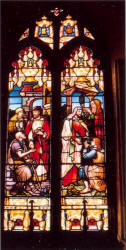 |
Windows on the south wall of the chancel and on the
south wall of the nave are memorials to Sir Richard Wallace
(1818-1870) Sir Richard was a great benefactor of Lisburn
and his collection of pictures and works of art is famous as
the "Wallace Collection". One of the memorial windows was
erected by public subscription and the other by Lady
Wallace. |
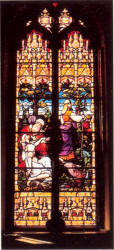 |
THE CHAPTER STALLS AND BISHOP'S THRONE
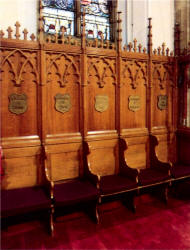 |
The bishop's throne, dedicated in 1893 and the
chapter stalls are located in the chancel. The chapter stalls represent
old ecclesiastical centres in the Diocese of Connor and districts in
County Antrim. |
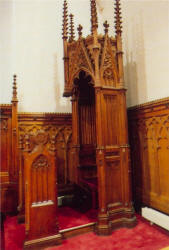 |
THE EAST WINDOW Te Deum Laudamus
The late Sir John Milne Barbour presented the East
Window in 1950 in memory of his wife Eliza Barbour and his son John
Milne Barbour who died in an aviation accident in 1937. A key to the
figures is given inside the back cover.

THE WORSHIPING AND SERVING CHURCH
If you have visited the Cathedral on a weekday it may
be difficult to visualise it in use for a variety of services of praise
and worship. The illustrations on these pages show something of the body
of people gathered to glorify God in both traditional and contemporary
forms of worship.
Celebration of the Holy Communion has a central place
in the monthly cycle of Sunday services. Other types of worship include
Family Service, Praise Service, and Healing Service.
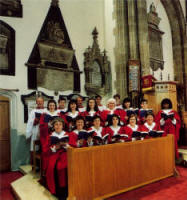 |
|
A robed choir leads the praise in the main Sunday
morning and evening services. |
Rearrangement of the Chancel area in 1990 provided
space for more members of the church to participate in leadership of
praise and prayer. It is now possible to seat a group of musicians with
a variety of instruments "making a joyful noise unto the Lord" and this
is often arranged for Family Services and Praise Services. A modern
sound amplification system ensures that the services can be clearly
heard in every part of the building. The system is sufficiently flexible
to allow for the varied uses required for instrumental groups and drama.
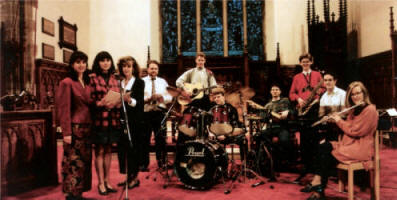
We look upon the Church as being like a garden, which
is alive and growing, requiring pnm�hg in some places to encourage new
growth. The illustrations therefore represent only a snapshot in time,
as the seasons change. The central message of the Gospel of Jesus Christ
is unchanging, but as society changes the way we worship changes -
reflecting new life and growth.
"GO, and Teach all Nations"
From its origin the church on this site has existed
to extend the Kingdom of God in the town of Lisburn and to equip its
members to carry the Christian message to other parts of the country and
the world. In the second half of the 20th century, ten men from Lisburn
Cathedral have trained for the ordained ministry and have been called to
serve in parishes in Ireland, England and further afield.
The Cathedral continues to encourage lay people to
Christian service at home and overseas. Men and women from the Parish
have undertaken long term missionary service in Africa and south
America, and the Cathedral has maintained links with Anglican Churches
in east Africa and Peru into the present decade.

THE CATHEDRAL HALL.
Externally, the Cathedral Hall is little changed
since it was constructed to house the Sunday School in 1884. It has been
used in many ways over the years, including a period of wartime service
when the Sunday School was held in the Cathedral. Major redevelopment of
the interior was carried out in 1989 to provide extra meeting rooms and
an upstair lounge without changing the exterior character of the
original building.
The main hall still serves its original purpose as a
Sunday School and accommodates a variety of weekday activities. There is
a spacious and well organised kitchen making it possible to cater for
parish lunches or larger functions. The upstair meeting rooms enable
large and small groups to meet in comfortable surroundings. In its new
form the Cathedral Hall continues to serve as a place for
teaching, counselling, Christian fellowship and other activities for
people of all ages.
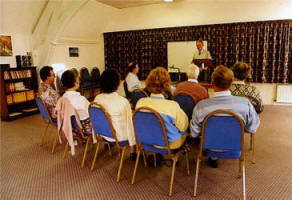 |
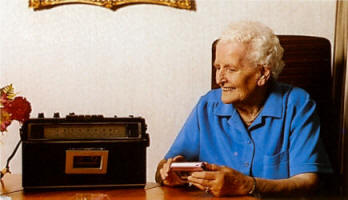 |
|
A small group meeting in one of the upstair
lounges of the Cathedral Hall |
Many
elderly or infirm members of the congregation who can no
longer attend services regularly continue to share in
worship by receiving a tape recording of the church services |
A CHURCHWARDEN'S FAITH STORY
The main function of any church is to help
individuals come to experience for themselves a living personal faith in
the One who is Lord of the Church, Jesus Christ. On this page,
one of the Cathedral's recent churchwardens relates his experience.
|
I was 43 years of age when I started to take stock of
my life. I was married to a wonderful wife, I had two grown up children,
and I was in a job that I enjoyed. We were buying our own home and had
all the comforts we desired Many may have longed for my style of life
but I realised that I was living in an artificial, plastic world. I
began to ask myself some searching questions - Is this all there is to
life I wondered
When I shared how I was feeling with my wife, I found
that she was having the same kind of thoughts as myself. Over the years
we had stopped going to church (although we ensured that our children
went to Sunday School) but now we decided to start attending our parish
church regularly. A couple we were friendly with gave us a Bible and I
started to read it. Ihad difficulty with the Old Testament but when I
started to read the Gospels I found that I could not read enough.
On reading John 3.3 I realised that I needed
to be born again like Nicodemus. One Sunday night in 19801 knelt down at
the side of my bed and asked the Lord to show me how I could be born
again. Nothing happened, and I went to bed downhearted, but later that
night I was awakened from sleep and felt God speaking to me. I gave my
life to Jesus at that moment and invited Him into my heart. I fell
asleep again and later I told my wife what had happened She said nothing
at that point , but about three weeks later the also gave her life to
Jesus. I presently discovered a new way of life as I joined in
fellowship with other believers in the Cathedral and progressed in my
Christian discipleship.
The Lord is a loving Saviour; He has not promised His
followers a life which is a bed of roses, but He does promise that He
will see us through every crisis that occurs in our lives and that He
will be our faithful Shepherd and Friend. I have proved this to be true
in my life.
I have experienced the heartache and grief of losing
my beloved wife: the died from cancer in March 1986 hi my loneliness and
anguish I could see no purpose or reason for living. But God did not
abandon me and He carried me through that dark period of my life.
Without His love I would never have survived that darkness I feel very
humble when I think about His care for me.
A whole new and unexpected area of Christian service
subsequently opened up for me. I intend to walk with the Lord through
this life and I know that He will guide me step by step along the way as
1 keep trusting hi Him.
|

GARDEN OF REMEMBRANCE
In every generation the Cathedral has had members or
clergy who have rendered outstanding service in the community and in the
nation. The style of memorial for outstanding service has changed over
the years with less prominence now given to murals on the interior of
the building.
In 1988 a garden of remembrance, for the interment of
ashes of parishioners after cremation, was constructed in the south east
corner of the churchyard. It was provided by Dr Garry McCartney, in
memory of his wife Marilyn. Garry McCartney served as a medical doctor
in Lisbum for 22 years before training for the Auxiliary Ministry of the
Church of Ireland. He died in 1992.
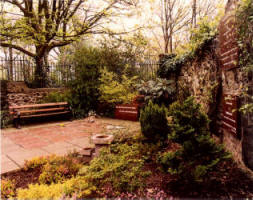 |
| The garden
of remembrance for the interment of ashes of parishioners
after cremation in the South east corner of the churchyard |
MURAL TABLETS
The mural tablets, many of which are grouped on the
north wall of the nave near the door through to the vestry, allow a
glimpse of the lives and service of many notable citizens of Lisburn
from the seventeenth century. Some of the memorials speak for
themselves, some require additional explanation. The work of two former
Rectors who did much to build up the fabric of the Cathedral is
commemorated as well as a famous Bishop. There are also notable soldiers
and sailors.
SOLDIERS AND SAILORS
Rawdon
A simple brass plate on the wall of the old chancel
records the location of the original burial vault which holds two
coffins one of which is believed to contain the remains of Sir George
Rawdon. The Rawdons or Roydons were an old Norman family, their ancestor
Paulyn Roydon having obtained a grant of the lands from which they
derive their name from William the Conqueror. It was Sir George who
defeated a rebel army in 1641 at Lisburn. His son Sir Arthur Rawdon was
M.P. for Down and was a distinguished soldier. He took part in the
defence of Londonderry during the siege.
Nicholson
General John Nicholson was born in Dublin, but spent
part of his boyhood in Lisburn. His parents were married in the
Cathedral. The memorial tablet, on the north wall of the nave, depicts
the siege of Delhi in 1857 in which he lost his life. The tablet was
erected by his mother and is the work of the great Irish sculptor John
Foley.
On the north wall of the nave there is a tablet in
memory of John Nicholson's brother, Major Charles Johnston Nicholson,
and his wife Lizzie Nicholson.

Dobbs
Lieutenant William Dobbs, whose memorial is on the
north wall of the nave, was the son of Rev Richard Dobbs, Rector of
Lisburn 1743-1775. Just after his marriage the lieutenant was staying at
the family seat, Castle Dobbs, near Carrickfergus when an American ship
Ranger, under the command of Captain Paul Jones, sailed into
Belfast Lough. The naval sloop Drake put out to engage the
Ranger and Lieutenant Dobbs, sailing on board the King's ship, lost
his life in the ensuing battle. There is no mention on the mural tablet
of Captain Jones who is now regarded as the father of the United States
navy.
Johnston-Smyth
Tablets on the south wall of the nave record the
service of two members of the Johnston-Smyth family which has been
associated with the Cathedral for generations:-Major Thomas Roger
Johnston-Smyth, killed in action in the South African war in 1900 and
Lieutenant Thomas Johnston-Smyth R.N. who died in trying to save his
shipmates of the coast of California in 1846.
CLERGY
Rev. Anthony Rogers The marble tablet on the south
wall of the nave records the work of the Rev. Rogers, Rector of the
Cathedral from 1727-1741. The vestry was built during his incumbency, as
recorded on a tablet over the north door. During his day parishioners on
the County Down side of the River Lagan revolted against payment of the
church assessment and the Parish took legal proceedings against them.
Bishop Jeremy Taylor
Jeremy Taylor came to County Antrim during the years
of the Commonwealth established under Oliver Cromwell and spent many
years in the district. He was invited by Lord Conway and settled as
private chaplain at Portmore on the shores of Lough Neagh in the Parish
of Ballinderry. At this time a man called Andrew Wyke (Weake?) was
Independent Minister in Lisburn , and under him Jeremy Taylor was
appointed to a "Lectureship". At the time of the Restoration of the
monarchy he was made Bishop of Down and Connor. He set himself to
restore the life and discipline of the Church of England in his Diocese,
which he accomplished with zeal and severity. He died in Lisburn in 1667
in a house which stood in Castle Street almost opposite the side
entrance to the Cathedral. The mural tablet in his memory was erected
about 1848 by Dr. Richard Mant, Bishop of Down, Connor and Dromore. The
epitaph reads:-
READER, THOUGH IT FALL NOT THY LOT TO ATTAIN TO THE
INTELLECTUAL GREATNESS OF THIS MASTER OF ISRAEL, YET THOU MAYEST RIVAL
HIM IN THAT WHICH WAS THE HIGHEST SCOPE EVEN OF HIS AMBITION, AN HONEST
CONSCIENCE AND A CHRISTIAN LIFE
The life work of Canon W.D. Pounden is commemorated
by a simple brass tablet on the north wall of the chancel, erected "by
the Primate of all Ireland, the Bishop of the Diocese, and his Brother
Clergy". Canon Pounden was Rector from 1884 to 1917. He did great work
in this Parish and was beloved by the people of Lisburn. During his
incumbency the chancel was constructed, windows in memory of Sir Richard
Wallace and the Bishops and Rectors were dedicated and the Parochial
Hall was completed.
Canon J.S.Taylor was Rector of Lisburn Cathedral from
1924 to 1950. His work is fittingly represented by the photograph below
showing the one hundred and two men of his Bible Class grouped outside
the Cathedral in 1929.
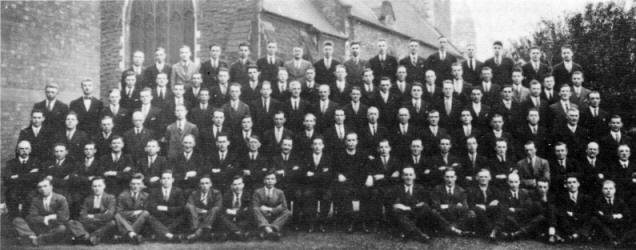

THE HUGUENOTS AND THE CATHEDRAL
In the year 1697, on the invitation of King William
III, Louis Crommelin settled in Lisburn. He was responsible for
improvement and organisation of the linen industry in Ulster. He was
followed by other Huguenot families and a French settlement grew up
around the district. For a time the Huguenots formed a distinct
congregation in Lisburn. They worshipped in the French Protestant Church
which was on the north side of Castle Street, mid-way between the side
entrance to the Cathedral and the Lisburn College. They had their own
pastors, and the services were conducted in their own language but they
were associated with the Cathedral. In one of the baptismal registers
there is a list of twenty-three names of children baptised by the Pastor
of the Huguenot community. Many of the decendants of Huguenot settlers
are living in Lisburn, some families have been in the Cathedral Parish
for generations.
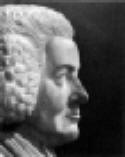 |
The Rev. Saumarez Dubourdieu was the last Huguenot
chaplain to minister to the French congregation in Lisburn. As the
congregation became smaller, and the settlers mingled and intermarried
with the local people, the French Church was closed. In course of time
the Rev- Dubourdieu became vicar of the Parish of Glenavy and was master
of the Classical School of Lisburn for fifty-six years. A memorial
tablet to his life and work is on the south wall of the nave. |
The grave of Louis Crommelin and other members of his
family is in the churchyard near the south east boundary.
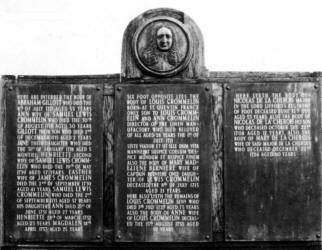
By 1964 the lettering on the Crommelin grave was
scarcely legible. The Irish Linen Industry arranged to have it engraved
in bronze. The unveiling ceremony was attended by descendants of the
families

Lisburn Cathedral gratefully acknowledges the
reproduction of much of the historical information from the late W. P.
Carmody's work: Lisburn Cathedral and its Past Rectors also, the
preparation of the cover illustration by Shirley Doran and the colour
photographs with the exception of the aerial view, by Alistair Hughes.
1993
Lisburn Cathedral, 24a Castle Street, Lisburn, Co Antrim
 |